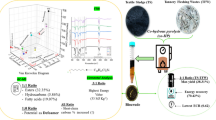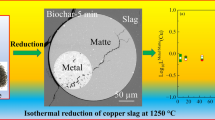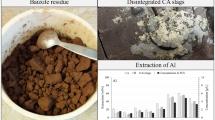Abstract
In this study, we evaluate the effect of hydrolysis treatment on the properties of tar and soot produced during the pyrolysis of sewage sludge at different operating temperatures (500–800 °C). The pyrolysis experiments were performed in a two-stage tubular fixed-bed reactor at atmospheric pressure. Raw sludge and hydrolysis-treated sludge (at pressure of 0.4 MPa and temperature 200 °C) samples were collected from local municipal sewage sludge treatment plant. The tar and soot samples obtained from pyrolysis at different temperatures were characterized by gas chromatography–mass spectrometry and scanning electron microscopy with energy dispersive X-ray spectroscopy, respectively. The results showed that increase in the pyrolysis temperature decreases the tar and soot yield for both raw and hydrolysis-treated sludge. The minimum tar yield was achieved with hydrolysis-treated sludge at 800 °C. The soot from raw sludge pyrolysis was of greater yield at high temperature than hydrolysis-treated sludge pyrolysis. The tar from pyrolysis of hydrolysis-treated sludge had more aliphatic character as compared to raw sewage sludge. The formation of heavy polycyclic aromatic hydrocarbons during pyrolysis of hydrolysis-treated sludge was lower at high temperatures than that of raw sludge. The aromatic hydrocarbons yield of hydrolysis-treated sludge was higher as compared to raw sludge at 800 °C.
Graphical Abstract






Similar content being viewed by others
References
Xiao, Z., Yuan, X., Li, H., Jiang, L., Leng, L., Chen, X., Zeng, G., Li, F., Cao, L.: Chemical speciation, mobility and phyto-accessibility of heavy metals in fly ash and slag from combustion of pelletized municipal sewage sludge. Sci. Total Environ. 536, 774–783 (2015). https://doi.org/10.1016/j.scitotenv.2015.07.126
Ali, M., Huang, Q., Lin, B., Hu, B., Wang, F., Chi, Y.: The effect of hydrolysis on combustion characteristics of sewage sludge and leaching behavior of heavy metals. Environ. Technol. (2017). https://doi.org/10.1080/09593330.2017.1363296
Liu, J., Fu, J., Ning, X.A., Sun, S., Wang, Y., Xie, W., Huang, S., Zhong, S.: An experimental and thermodynamic equilibrium investigation of the Pb, Zn, Cr, Cu, Mn and Ni partitioning during sewage sludge incineration. J. Environ. Sci. 35, 43–54 (2015). https://doi.org/10.1016/j.jes.2015.01.027
Karayildirim, T., Yanik, J., Yuksel, M., Bockhorn, H.: Characterisation of products from pyrolysis of waste sludges. Fuel 85(10), 1498–1508 (2006). https://doi.org/10.1016/j.fuel.2005.12.002
Wang, Z., Ma, X., Yao, Z., Yu, Q., Wang, Z., Lin, Y.: Study of the pyrolysis of municipal sludge in N2/CO2 atmosphere. Appl. Therm. Eng. 128, 662–671 (2018). https://doi.org/10.1016/j.applthermaleng.2017.09.044
Kim, Y., Parker, W.: A technical and economic evaluation of the pyrolysis of sewage sludge for the production of bio-oil. Bioresour. Technol. 99(5), 1409–1416 (2008). https://doi.org/10.1016/j.biortech.2007.01.056
Zielińska, A., Oleszczuk, P.: The conversion of sewage sludge into biochar reduces polycyclic aromatic hydrocarbon content and ecotoxicity but increases trace metal content. Biomass Bioenergy 75, 235–244 (2015). https://doi.org/10.1016/j.biombioe.2015.02.019
Chen, H., Namioka, T., Yoshikawa, K.: Characteristics of tar, NOx precursors and their absorption performance with different scrubbing solvents during the pyrolysis of sewage sludge. Appl. Energy 88(12), 5032–5041 (2011). https://doi.org/10.1016/j.apenergy.2011.07.007
Hernandez, A.B., Ferrasse, J.-H., Chaurand, P., Saveyn, H., Borschneck, D., Roche, N.: Mineralogy and leachability of gasified sewage sludge solid residues. J. Hazard. Mater. 191(1), 219–227 (2011). https://doi.org/10.1016/j.jhazmat.2011.04.070
Lv, G., Wu, S.: Analytical pyrolysis studies of corn stalk and its three main components by TG–MS and Py-GC/MS. J. Anal. Appl. Pyrolysis 97, 11–18 (2012). https://doi.org/10.1016/j.jaap.2012.04.010
Lin, B., Wang, J., Huang, Q., Ali, M., Chi, Y.: Aromatic recovery from distillate oil of oily sludge through catalytic pyrolysis over Zn modified HZSM-5 zeolites. J. Anal. Appl. Pyrolysis 128, 291–303 (2017). https://doi.org/10.1016/j.jaap.2017.09.021
Fang, S., Yu, Z., Ma, X., Lin, Y., Lin, Y., Chen, L., Fan, Y., Liao, Y.: Co-pyrolysis characters between combustible solid waste and paper mill sludge by TG–FTIR and Py-GC/MS. Energy Convers. Manag. 144, 114–122 (2017). https://doi.org/10.1016/j.enconman.2017.04.046
Hac Ko, J., Wang, J., Xu, Q.: Characterization of particulate matter formed during sewage sludge pyrolysis. Fuel 224, 210–218 (2018). https://doi.org/10.1016/j.fuel.2018.02.189
Dai, Q., Jiang, X., Lv, G., Ma, X., Jin, Y., Wang, F., Chi, Y., Yan, J.: Investigation into particle size influence on PAH formation during dry sewage sludge pyrolysis: TG–FTIR analysis and batch scale research. J. Anal. Appl. Pyrolysis 112, 388–393 (2015). https://doi.org/10.1016/j.jaap.2014.09.015
Huang, X., Cao, J.-P., Shi, P., Zhao, X.-Y., Feng, X.-B., Zhao, Y.-P., Fan, X., Wei, X.-Y., Takarada, T.: Influences of pyrolysis conditions in the production and chemical composition of the bio-oils from fast pyrolysis of sewage sludge. J. Anal. Appl. Pyrolysis 110, 353–362 (2014). https://doi.org/10.1016/j.jaap.2014.10.003
Inguanzo, M., Domı́nguez, A., Menéndez, J.A., Blanco, C.G., Pis, J.J.: On the pyrolysis of sewage sludge: the influence of pyrolysis conditions on solid, liquid and gas fractions. J. Anal. Appl. Pyrolysis 63(1), 209–222 (2002). https://doi.org/10.1016/S0165-2370(01)00155-3
Gong, Z., Du, A., Wang, Z., Fang, P., Li, X.: Experimental study on pyrolysis characteristics of oil sludge with a tube furnace reactor. Energy Fuels 31(8), 8102–8108 (2017). https://doi.org/10.1021/acs.energyfuels.7b01363
Nedjalkov, I., Yoshiie, R., Ueki, Y., Naruse, I.: Tar and soot generation behaviors from ABS, PC and PE pyrolysis. J. Mater. Cycles Waste Manag. 19(2), 682–693 (2017). https://doi.org/10.1007/s10163-016-0470-7
Cho, M.-H., Jung, S.-H., Kim, J.-S.: Pyrolysis of mixed plastic wastes for the recovery of benzene, toluene, and xylene (BTX) aromatics in a fluidized bed and chlorine removal by applying various additives. Energy Fuels 24(2), 1389–1395 (2010). https://doi.org/10.1021/ef901127v
López, A., de Marco, I., Caballero, B.M., Laresgoiti, M.F., Adrados, A.: Influence of time and temperature on pyrolysis of plastic wastes in a semi-batch reactor. Chem. Eng. J. 173(1), 62–71 (2011). https://doi.org/10.1016/j.cej.2011.07.037
Sánchez, N., Callejas, A., Millera, A., Bilbao, R., Alzueta, M.: Determination of polycyclic aromatic hydrocarbons (PAH) adsorbed on soot formed in pyrolysis of acetylene at different temperatures. Chem. Eng. Trans. 22, 131–136 (2010)
Mendiara, T., Domene, M.P., Millera, A., Bilbao, R., Alzueta, M.U.: An experimental study of the soot formed in the pyrolysis of acetylene. J. Anal. Appl. Pyrolysis 74(1), 486–493 (2005). https://doi.org/10.1016/j.jaap.2004.11.019
Umeki, K., Häggström, G., Bach-Oller, A., Kirtania, K., Furusjö, E.: Reduction of tar and soot formation from entrained-flow gasification of woody biomass by alkali impregnation. Energy Fuels 31(5), 5104–5110 (2017)
Sánchez, N.E., Callejas, A., Millera, Á., Bilbao, R., Alzueta, M.U.: Polycyclic aromatic hydrocarbon (PAH) and soot formation in the pyrolysis of acetylene and ethylene: effect of the reaction temperature. Energy Fuels 26(8), 4823–4829 (2012). https://doi.org/10.1021/ef300749q
de Andrés, J.M., Roche, E., Narros, A., Rodríguez, M.E.: Characterisation of tar from sewage sludge gasification. Influence of gasifying conditions: temperature, throughput, steam and use of primary catalysts. Fuel 180, 116–126 (2016). https://doi.org/10.1016/j.fuel.2016.04.012
Dai, Q., Jiang, X., Jiang, Y., Jin, Y., Wang, F., Chi, Y., Yan, J.: Formation of PAHs during the pyrolysis of dry sewage sludge. Fuel 130, 92–99 (2014). https://doi.org/10.1016/j.fuel.2014.04.017
Lim, M.-S., Chun, Y.-N.: Light tar decomposition of product pyrolysis gas from sewage sludge in a gliding arc plasma reformer. Environ. Eng. Res. 17(2), 89–94 (2012)
Aubagnac-Karkar, D., El Bakali, A., Desgroux, P.: Soot particles inception and PAH condensation modelling applied in a soot model utilizing a sectional method. Combust. Flame 189, 190–206 (2018)
Phuphuakrat, T., Namioka, T., Yoshikawa, K.: Tar removal from biomass pyrolysis gas in two-step function of decomposition and adsorption. Appl. Energy 87(7), 2203–2211 (2010). https://doi.org/10.1016/j.apenergy.2009.12.002
Anis, S., Zainal, Z.: Tar reduction in biomass producer gas via mechanical, catalytic and thermal methods: a review. Renew. Sustain. Energy Rev. 15(5), 2355–2377 (2011)
Shen, Y., Yoshikawa, K.: Recent progresses in catalytic tar elimination during biomass gasification or pyrolysis—a review. Renew. Sustain. Energy Rev. 21, 371–392 (2013). https://doi.org/10.1016/j.rser.2012.12.062
Abdoulmoumine, N., Adhikari, S., Kulkarni, A., Chattanathan, S.: A review on biomass gasification syngas cleanup. Appl. Energy 155, 294–307 (2015). https://doi.org/10.1016/j.apenergy.2015.05.095
Hong, S.-P., Dong, J.-I., Yeo, S.-K., Park, I.-H., Chung, M.-S., Kim, D.-I., Park, Y.-K.: Reduction of tar using cheap catalysts during sewage sludge gasification. J. Mater. Cycles Waste Manag. 13(3), 186–189 (2011)
Göktepe, B., Umeki, K., Gebart, R.: Does distance among biomass particles affect soot formation in an entrained flow gasification process? Fuel Process. Technol. 141, 99–105 (2016)
Göktepe, B., Umeki, K., Hazim, A., Lundström, T.S., Gebart, R.: Soot reduction in an entrained flow gasifier of biomass by active dispersion of fuel particles. Fuel 201, 111–117 (2017). https://doi.org/10.1016/j.fuel.2016.09.039
Devi, L., Ptasinski, K.J., Janssen, F.J.J.G.: Pretreated olivine as tar removal catalyst for biomass gasifiers: investigation using naphthalene as model biomass tar. Fuel Process. Technol. 86(6), 707–730 (2005). https://doi.org/10.1016/j.fuproc.2004.07.001
Chun, Y.N.: Production of activated char and producer gas sewage sludge. In: Integrated Waste Management, vol I. InTech, London (2011)
Phuphuakrat, T., Nipattummakul, N., Namioka, T., Kerdsuwan, S., Yoshikawa, K.: Characterization of tar content in the syngas produced in a downdraft type fixed bed gasification system from dried sewage sludge. Fuel 89(9), 2278–2284 (2010). https://doi.org/10.1016/j.fuel.2010.01.015
Zhang, K., Li, H., Wu, Z., Mi, T.: The thermal cracking experiment research of tar model compound. In: Energy and International Conference on Environment Technology, 2009, ICEET’09, pp. 655–659. IEEE (2009)
Pfeifer, C., Hofbauer, H.: Development of catalytic tar decomposition downstream from a dual fluidized bed biomass steam gasifier. Powder Technol. 180(1), 9–16 (2008). https://doi.org/10.1016/j.powtec.2007.03.008
Suárez-Iglesias, O., Urrea, J.L., Oulego, P., Collado, S., Díaz, M.: Valuable compounds from sewage sludge by thermal hydrolysis and wet oxidation. A review. Sci. Total Environ. 584–585, 921–934 (2017). https://doi.org/10.1016/j.scitotenv.2017.01.140
Feng, G., Tan, W., Zhong, N., Liu, L.: Effects of thermal treatment on physical and expression dewatering characteristics of municipal sludge. Chem. Eng. J. 247, 223–230 (2014). https://doi.org/10.1016/j.cej.2014.03.005
Li, Y., Xue, F., Li, J., Xu, S.H., Li, D.: Migration and transformation rule of heavy metals in sludge during hydrolysis for protein extraction. Environ. Sci. Pollut. Res. 23(6), 5352–5360 (2016). https://doi.org/10.1007/s11356-015-5646-5
Leng, L., Yuan, X., Huang, H., Jiang, H., Chen, X., Zeng, G.: The migration and transformation behavior of heavy metals during the liquefaction process of sewage sludge. Bioresour. Technol. 167, 144–150 (2014). https://doi.org/10.1016/j.biortech.2014.05.119
Lin, M., Ning, X.-A., Liang, X., Wei, P., Wang, Y., Liu, J.: Study of the heavy metals residual in the incineration slag of textile dyeing sludge. J. Taiwan Inst. Chem. Eng. 45(4), 1814–1820 (2014). https://doi.org/10.1016/j.jtice.2014.02.008
Neyens, E., Baeyens, J.: A review of thermal sludge pre-treatment processes to improve dewaterability. J. Hazard. Mater. 98(1), 51–67 (2003). https://doi.org/10.1016/S0304-3894(02)00320-5
Barber, W.P.F.: Thermal hydrolysis for sewage treatment: a critical review. Water Res. 104, 53–71 (2016). https://doi.org/10.1016/j.watres.2016.07.069
Higgins, M.J., Chen, Y.-C., Yarosz, D.P., Murthy, S.N., Maas, N.A., Glindemann, D., Novak, J.T.: Cycling of volatile organic sulfur compounds in anaerobically digested biosolids and its implications for odors. Water Environ. Res. 78(3), 243–252 (2006). https://doi.org/10.2175/106143005x90065
Wu, H., Li, M., Zhang, L., Sheng, C.: Research on the stability of heavy metals (Cu, Zn) in excess sludge with the pretreatment of thermal hydrolysis. Water Sci. Technol. 73(4), 890–898 (2016). https://doi.org/10.2166/wst.2015.537
Magdziarz, A., Wilk, M.: Thermogravimetric study of biomass, sewage sludge and coal combustion. Energy Convers. Manag. 75, 425–430 (2013)
Qin, Y., Huang, H., Wu, Z., Feng, J., Li, W., Xie, K.: Characterization of tar from sawdust gasified in the pressurized fluidized bed. Biomass Bioenergy 31, 243–249 (2007)
Li, X.T., Grace, J.R., Lim, C.J., Watkinson, A.P., Chen, H.P., Kim, J.R.: Biomass gasification in a circulating fluidized bed. Biomass Bioenergy 26(2), 171–193 (2004). https://doi.org/10.1016/S0961-9534(03)00084-9
Fonts, I., Gea, G., Azuara, M., Ábrego, J., Arauzo, J.: Sewage sludge pyrolysis for liquid production: a review. Renew. Sustain. Energy Rev. 16(5), 2781–2805 (2012). https://doi.org/10.1016/j.rser.2012.02.070
Wongchang, T., Patumsawad, S., Fungtammasan, B.: An analysis of wood pyrolysis tar from high temperature thermal cracking process. Energy Sources A (2013). https://doi.org/10.1080/15567036.2012.707748
Jin, Q., Wang, X., Li, S., Mikulčić, H., Bešenić, T., Deng, S., Vujanović, M., Tan, H., Kumfer, B.M.: Synergistic effects during co-pyrolysis of biomass and plastic: gas, tar, soot, char products and thermogravimetric study. J. Energy Inst. 92(1), 108–117 (2019). https://doi.org/10.1016/j.joei.2017.11.001
Jin, Q., Wang, X., Li, S., Mikulčić, H., Bešenić, T., Deng, S., Vujanović, M., Tan, H., Kumfer, B.M.: Synergistic effects during co-pyrolysis of biomass and plastic: gas, tar, soot, char products and thermogravimetric study. J. Energy Inst. (2017). https://doi.org/10.1016/j.joei.2017.11.001
Liu, T., Guo, Y., Peng, N., Lang, Q., Xia, Y., Gai, C., Liu, Z.: Nitrogen transformation among char, tar and gas during pyrolysis of sewage sludge and corresponding hydrochar. J. Anal. Appl. Pyrolysis 126, 298–306 (2017). https://doi.org/10.1016/j.jaap.2017.05.017
Sánchez, M.E., Menéndez, J.A., Domínguez, A., Pis, J.J., Martínez, O., Calvo, L.F., Bernad, P.L.: Effect of pyrolysis temperature on the composition of the oils obtained from sewage sludge. Biomass Bioenergy 33(6), 933–940 (2009). https://doi.org/10.1016/j.biombioe.2009.02.002
Cunliffe, A.M., Williams, P.T.: Composition of oils derived from the batch pyrolysis of tyres. J. Anal. Appl. Pyrolysis 44(2), 131–152 (1998). https://doi.org/10.1016/S0165-2370(97)00085-5
Cypres, R.: Aromatic hydrocarbons formation during coal pyrolysis. Fuel Process. Technol. 15, 1–15 (1987). https://doi.org/10.1016/0378-3820(87)90030-0
Morf, P., Hasler, P., Nussbaumer, T.: Mechanisms and kinetics of homogeneous secondary reactions of tar from continuous pyrolysis of wood chips. Fuel 81(7), 843–853 (2002). https://doi.org/10.1016/S0016-2361(01)00216-2
Wang, X., Li, Y., Bai, S., Jin, Q., Mikulčić, H., Tan, H., Vujanović, M.: Nano-scale soot particle formation during the high-temperature pyrolysis of waste plastics in an entrained flow reactor. Waste Biomass Valoriz. (2018). https://doi.org/10.1007/s12649-018-0322-x
Ruiz, M.P., de Villoria, R.G., Millera, A., Alzueta, M.U., Bilbao, R.: Influence of the temperature on the properties of the soot formed from C2H2 pyrolysis. Chem. Eng. J. 127(1), 1–9 (2007). https://doi.org/10.1016/j.cej.2006.09.006
Jaramillo, I.C., Gaddam, C.K., Vander Wal, R.L., Huang, C.-H., Levinthal, J.D., Lighty, J.S.: Soot oxidation kinetics under pressurized conditions. Combust. Flame 161(11), 2951–2965 (2014). https://doi.org/10.1016/j.combustflame.2014.04.016
Acknowledgements
This research was financially supported by the National Natural Science Foundation of China (Grant No. 51576172) and the Environmental Protection Special Funds for Public Welfare (201509013) and the Fundamental Research Funds for the Central Universities.
Author information
Authors and Affiliations
Corresponding author
Ethics declarations
Conflict of interest
No potential conflict of interest was reported by the authors.
Additional information
Publisher's Note
Springer Nature remains neutral with regard to jurisdictional claims in published maps and institutional affiliations.
Rights and permissions
About this article
Cite this article
Ali, M., Huang, Q., Wang, Y. et al. The Effect of Hydrolysis on Properties of Soot and Tar During the Pyrolysis of Sewage Sludge. Waste Biomass Valor 11, 3433–3442 (2020). https://doi.org/10.1007/s12649-019-00685-y
Received:
Accepted:
Published:
Issue Date:
DOI: https://doi.org/10.1007/s12649-019-00685-y




